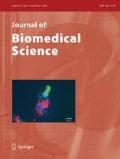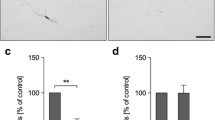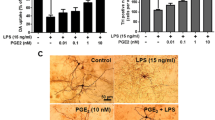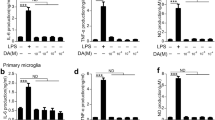Abstract
Previously we reported that ultralow concentrations of dynorphins (10−16 to 10−12 M) inhibited lipopolysaccharide (LPS)-induced production of nitric oxide (NO) and proinflammatory cytokines in mouse glia without the participation of κ-opioid receptors. In the current study using mouse cortical neuron-glia cocultures, we examined the possibility that inhibition of glia inflammatory response by dynorphins might be neuroprotective for neurons. LPS, in a concentration-dependent manner, markedly increased the release of lactate dehydrogenase (LDH), an indicator of cellular injury. Ultralow concentrations (10−14 to 10−12 M) of dynorphin (dyn) A-(1–8) significantly prevented the LPS-induced release of LDH, loss of neurons, and changes in cell morphology, in addition to inhibition of LPS-induced nitrite production. Meanwhile, ultralow concentrations (10−15 to 10−13 M) of des-[Tyr1]-dyn A-(2–17), a nonopioid peptide which does not bind to κ-opioid receptors, exhibited the same inhibitory effect as dyn A-(1–17). These results suggest that dynorphins at ultralow concentrations are capable of reducing LPS-induced neuronal injury and these neuroprotective effects of dynorphins are not mediated by classical opioid receptors.
Similar content being viewed by others
References
Anderson PB, Perry VH, Gordon S. The acute inflammatory response to lipopolysaccharide in CNS parenchyma differ from that in other body tissues. Neuroscience 48:169–186;1992.
Baskin DS, Kuroda H, Hosobuchi Y, Lee NM. Treatment of stroke with opiate antagonists: Effects of exogenous antagonists and dynorphin 1–13. Neuropeptides 5:307–310;1985.
Benveniste EN. Cytokine circuits in brain: Implications for AIDS dementia complex. In: Price RW, Perry SW, eds. HIV, AIDS and the Brain. New York, Raven Press, 71–88;1994.
Bourdiol F, Toulmond S, Serrano A, Benavides J, Scatton B. Increase in ω3 (peripheral type benzodiazepine) binding sites in the rat cortex and striatum after local injection of interleukin-1, tumor necrosis factor-α and lipopolysaccharide. Brain Res 543:194–200;1991.
Bronstein DM, Perez-Otano I, Sun V, Mullis Sawin SB, Chan J, Wu G-C, Hudson PM, Kong L-Y, Hong J-S, McMillian MK. Glia-dependent neurotoxicity and neuroprotection in mesencephalic cultures. Brain Res 704:112–116;1995.
Carr DJJ. The role of endogenous opioids and their receptors in the immune system. Proc Soc Exp Biol Med 198:710–720;1991.
Chao CC, Hu S, Molitor TW, Shaskan EG, Peterson PK. Activated microglia mediate neuronal cell injury via a nitric oxide mechanism. J Immunol 149:2736–2741;1992.
Chao CC, Gekker G, Hu S, Sheng WS, Portoghese PS, Peterson PK. Upregulation of HIV-1 expression in cocultures of chronically infected promonocytes and human brain cells by dynorphin. Biochem Pharmacol 50:715–722;1995.
Chao CC, Gekker G, Sheng WS, Hu S, Portoghese PS, Peterson PK. Endogenous opioid peptides suppress cytokine-mediated upregulation of HIV-1 expression in the chronically infected promonocyte clone U1. In: Sharp B, Eisenstein T, Madden J, Friedman H, eds. Brain Immune Axis and Substance Abuse. London, Plenum Press, 65–72;1995.
Chen L, Gu Y, Huang L-YM. Opioid peptide dynorphin directly blocks NMDA-receptor channels in the rat. J Physiol 482:575–581;1995.
Chen L, Gu Y, Huang L-YM. The mechanism of action for the block of NMDA receptor channels by opioid peptide dynorphin. J Neurosci 15:4602–4611;1995.
Das KP, Hong J-S, Sanders VM. Ultralow concentrations of proenkephalin and [Met5]-enkephalin differentially affect IgM and IgG production by B cells. J Neuroimmunol 73:37–46;1997.
Dawson TM, Dawson VL, Snyder SH. A novel neuronal messenger molecule in brain: The free radical, nitric oxide. Ann Neurol 32:297–311;1992.
Dawson VL, Dawson TM, London ED, Bredt DS, Snyder SH. Nitric oxide mediates glutamate neurotoxicity in primary cortical cultures. Proc Natl Acad Sci USA 88:6368–6371;1991.
Dawson VL, Dawson TM, Uhl GR, Snyder SH. Mechanisms of nitric oxide-mediated neurotoxicity in primary brain cultures. J Neurosci 13:2651–2661;1993.
Dawson VL, Brahmbhatt HP, Mong JA, Dawson TM. Expression of inducible nitric oxide synthase causes delayed neurotoxicity in primary mixed neuronal-glial cortical cultures. Neuropharmacology 33:1425–1430;1994.
Demerle-Pallardy C, Lonchampt M-O, Chabrier P-E, Braquet P. Absence of implication ofL-arginine/nitric oxide pathway on neuronal cell injury induced byL-glutamate or hypoxia. Biochem Biophys Res Commun 181:456–464;1991.
Dickson DW, Lee SC, Mattiace LA, Yen S-HC, Brosnan C. Microglia and cytokines in neurological diseases, with special reference to AIDS and Alzheimer's disease. Glia 7:75–83;1993.
Efanov AM, Koshkin AA, Sazanov LA, Borodulina OI, Varfolomeev SD, Zaitsev SV. Inhibition of the respiratory burst in mouse macrophages by ultra-low doses of an opioid peptide is consistent with a possible adaptation mechanism. FEBS Lett 355:114–116;1994.
Foster JS, Moore RN. Dynorphin and related opioid peptides enhance tumoricidal activity mediated by murine peritoneal macrophages. J Leukoc Biol 42:171–174;1987.
Garthwaite G, Garthwaite J. Nitric oxide does not mediate acute glutamate neurotoxicity, nor is it neuroprotective, in rat brain slices. Neuropharmacology 33:1431–1438;1994.
Giulian D, Woodward J, Young DG, Krebs JB, Lachman LB. Interleukin 1 injected into mammalian brain stimulates astrogliosis and neovascularization. J Neurosci 8:2485–2490;1988.
Giulian D, Li J, Li X, George J, Rutecki PA. The impact of microglia-derived cytokines upon gliosis in the CNS. Dev Neurosci 16:128–136;1994.
Hewett SJ, Csernansky CA, Choi DW. Selective potentiation of NMDA-induced neuronal injury following induction of astrocytic iNOS. Neuron 13:487–494;1994.
Hofman FM, Hinton DR, Johnson K, Merrill JE. Tumor necrosis factor identified in multiple sclerosis brain. J Exp Med 170:607–612;1989.
Huang Z, Huang PL, Panahian N, Dalkara T, Fishman MC, Moskowitz MA. Effects of cerebral ischemia in mice deficient in neuronal nitric oxide synthase. Science 265:1883–1885;1994.
Ichinose M, Asai M, Sawada M. Enhancement of phagocytosis by dynorphin A in mouse peritoneal macrophages. J Neuroimmunol 60:37–43;1995.
Koh JY, Choi DW. Quantitative determination of glutamate mediated cortical neuronal injury in cell culture by lactate dehydrogenase efflux assay. J Neurosci Methods 20:83–90;1987.
Kong L-Y, McMillian MK, Hudson PM, Jin L, Hong J-S. Inhibition of lipopolysaccharide-induced nitric oxide and cytokine production by ultralow concentrations of dynorphins in mixed glia cultures. J Pharmacol Exp Ther 280:61–66;1997.
Kuroda H, Baskin DS, Matsui T, Loh HH, Hosobuchi Y, Lee NM. Effects of dynorphin 1–13 on opiate binding and dopamine and GABA uptake in stroked cat brain. Brain Res 379:68–74;1986.
Lei SZ, Pan Z-H, Aggarwal SK, Chen H-SV, Hartman J, Sucher NJ, Lipton SA. Effect of nitric oxide production on the redox modulatory site of the NMDA receptor-channel complex. Neuron 8:1087–1099;1992.
Lipton SA, Chol Y-B, Pan Z-H, Lei SZ, Chen H-SV, Hartman J, Sucher NJ, Loscalzo J, Singel DJ, Stamler JS. A redox based mechanism for the neuroprotective and neurodestructive effects of NO and related nitroso-compounds. Nature 364:626–631;1993.
Manzoni O, Prezeau L, Marin P, Deshager S, Bockaret J, Fagni L. Nitric oxide-induced blockade of NMDA receptors. Neuron 8:653–662;1992.
McMillian M, Mullis SB, Wu G-C, Hudson PM, Pennypacker KR, Hong J-S. Regulation of tyrosine hydroxylase in olfactory bulb cultures: Selective inhibition of depolarization-induced increase by endogenous opioids. Brain Res 658:105–111;1994.
McMillian M, Kong L-Y, Mullis Sawin S, Wilson B, Das K, Hudson P, Hong J-S, Bing G. Selective killing of cholinergic neurons by microglial activation in basal forebrain mixed neuronal/glial cultures. Biochem Biophys Res Commun 215:572–577;1995.
Mogi M, Harada M, Kondo T, Riederer P, Inagaki H, Minami M, Nagatsu T. Interleukin-1β, interleukin-6, epidermal growth factor and transforming growth factor-α are elevated in the brain from parkinsonian patients. Neurosci Lett 180:147–150;1994.
Pauwels PJ, Leysen JE. Blockade of nitric oxide formation does not prevent glutamate-induced neurotoxicity in neuronal cultures from rat hippocampus. Neurosci Lett 143:27–30;1992.
Prete P, Levin ER, Pedram A. The in vitro effects of endogenous opiates on natural killer cells, antigen-specific cytolytic cell, and T-cell subsets. Exp Neurol 92:340–359;1986.
Regan RF, Renn KE, Panter SS. NMDA neurotoxicity in murine cortical cell cultures is not attenuated by hemoglobin or inhibition of nitric oxide synthesis. Neurosci Lett 153:53–56;1993.
Selmaj KW, Raine CS. Tumor necrosis factor mediates myelin and oligodendrocyte damage in vitro. Ann Neurol 23:339–346;1988.
Sibinga NE, Goldstein A. Opioid peptides and opioid receptors in cells of the immune system. Annu Rev Immunol 6:219–249;1988.
Simon EJ. Recent studies on opioid receptors: Heterogeneity and purification. Ann NY Acad Sci 463:31–35;1986.
Stefano GB. Role of opioid neuropeptides in immunoregulation. Prog Neurobiol 33:149–159;1989.
Stuehr DJ, Nathan CF. Nitric oxide: A macrophage product responsible for cytostasis and respiratory inhibition in tumor target cells. J Exp Med 169:1543–1555;1989.
Williamson SA, Knight RA, Lightman SL, Hobbs JR. Effects of beta endorphin on specific immune responses in man. Immunology 65:47–51;1988.
Wink DA, Hanbauer I, Krishna MC, Degraff W, Gamson J, Mitchell JB. Nitric oxide protects against cellular damage and cytotoxicity from reactive oxygen species. Proc Natl Acad Sci USA 90:9813–9817;1993.
Woo SK, Tulunay FC, Loh HH, Lee NM. Effect of dynorphin 1–13 and related peptides on respiratory rate and morphine-induced respiratory rate depression. Eur J Pharmacol 96:117–122;1983.
Zaitsev SV, Sazanov LA, Koshkin AA, Sudina GF, Varfolomeev SD. Respiratory burst inhibition in human neutrophils by ultralow doses of [D-Ala2]methionine enkephalinamide. FEBS Lett 291:84–86;1991.
Author information
Authors and Affiliations
Rights and permissions
About this article
Cite this article
Kong, LY., Jeohn, GH., Hudson, P.M. et al. Reduction of lipopolysaccharide-induced neurotoxicity in mouse mixed cortical neuron/glia cultures by ultralow concentrations of dynorphins. J Biomed Sci 7, 241–247 (2000). https://doi.org/10.1007/BF02255472
Issue Date:
DOI: https://doi.org/10.1007/BF02255472




